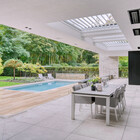Anodizing
Powder coating is a popular form of surface treatment. But not the only one. You can also opt for anodizing. In the standard, silver colour, so-called natural anodising. Or with colour.
Anodising is an electrolytic process in which a transparent oxide layer is applied in a controlled manner. The aluminium retains its natural appearance. This oxide layer offers protection against corrosion and wear. Anodizing actually speeds up the natural oxidation process of aluminium.
The anodizing process
Anodizing requires a number of successive steps. The first is pickling. A layer of aluminium is dissolved in this process. The result is an even, matt surface. The aluminium is then connected to the anode in an anodizing bath. The surface is then oxidized to the desired thickness by means of electrolysis. This oxide layer is still porous. The pores are finally closed (sealed) in a warm water bath.
Natural anodizing
If protection is the only motivation, then of course anodising is an economical option. This blank anodizing is popular for objects that are not (easily) visible to the outside world. Or if there are no aesthetic requirements for appearance. For example, in industrial applications.
Anodizing with colour
Anodizing with colour is also an option. The colour is applied after the anodizing bath, before sealing. The pores of the oxide layer can then still absorb dyes. Available colours are silver, gold, bronze, copper, gray, black, blue, red, green.
Pre-treatments
Aluminium can optionally be pre-treated prior to the anodization process. Popular pre-treatments are brushing and polishing. After the pre-treatment, the aluminium is then anodized. Blank or with one colour.



